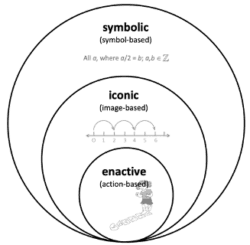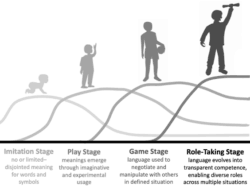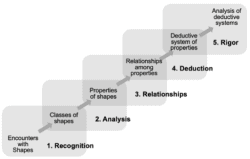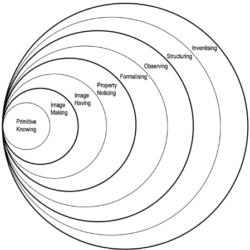Focus
Varied modes of acting/engaging associated with specific competenciesPrincipal Metaphors
- Knowledge is … repertoire of possibilities
- Knowing is … appropriate mode of doing
- Learner is … an actor (individual)
- Learning is … developing more powerful modes of doing
- Teaching is … presenting appropriate challenges
Originated
mid-1900sSynopsis
Stages of Understanding Models are concerned with the emergence of specific competencies or disciplinary knowledge. (Contrast the more generic character of Levels of Learning Models.) Most of these models are explicitly aligned with one or more Non-Trivial Constructivisms. As well, they tend to assume similar principles of growth and change as Developmental Discourses, albeit that those principles are applied at much smaller conceptual scales and usually across shorter timeframes. (That is, Developmental Discourses tend to be unconcerned with specific competencies or concepts and more focused on such broad phenomena as identity, agency, and modes of consciousness as they unfold over a lifetime.) Virtually all Stages of Understanding Models assume or assert nonlinear, recursive dynamics. They typically problematize notions of progress along stable trajectories, opting instead to describe learning in terms of enlarging repertoires of possibility through the iterative development of more-and-more powerful interpretive strategies and communicative competencies. In terms of visual metaphors, modes of knowing are often represented as nested regions, which are intended to signify how earlier modes/competencies might be retained but superseded. An attempt at a reasonably comprehensive listing of Stages of Understanding Models exceeds the intentions and means of this website, given their extensive numbers and skill- or discipline-specific foci. However, for illustrative purposes, some prominent discourses are described below.FORMAL–LOGICAL THINKING
- Concrete–Abstract – one of the most ubiquitous dyads among theories and models of learning and development, the terms “concrete” and “abstract” are typically used to signal a transition from relying on object-based and/or physical encounters/interpretations/meanings to using more formal and generalizable concepts. Some places that this dyad is encountered include Bruner’s Three Modes of Representation (see below), Jean Piaget's Stage Theory of Cognitive Development (see Cognitive Developmentalisms), and Learning Toys and Tools. Usually, but not always, the concrete is regarded as lesser than and prior to the abstract.
- Abstraction Ladder (S. I. Hayakawa, 1930s) – a model for understanding how language can range from very concrete terms to highly abstract concepts – and how, accordingly, abstract language can obscure meaning or reduce clarity, while more concrete language can improve understanding. The following rungs are typical across the many variations of the Abstraction Ladder that have been developed:
- Concrete Level – specific, observable details (e.g., a cow named “Bessie”)
- Individual Object – a less-specific example (e.g., a cow)
- Class of Objects – a category or type (e.g., livestock)
- Broader Class – a larger category or grouping (e.g., farm assets)
- Generalized Concept – an abstract, broad term (e.g., resources or wealth)
 Bruner’s Three Modes of Representation (Jerome Bruner, 1960s) – While not discipline-specific, this model looks at the intersection of types of experience and means of representation in its suggestion that humans have three principal modes of interpreting experience (described below). Although Bruner associated the prevalence of these modes with age ranges, he also acknowledged that even sophisticated experts routinely engage all modes when encountering novel problems.
Bruner’s Three Modes of Representation (Jerome Bruner, 1960s) – While not discipline-specific, this model looks at the intersection of types of experience and means of representation in its suggestion that humans have three principal modes of interpreting experience (described below). Although Bruner associated the prevalence of these modes with age ranges, he also acknowledged that even sophisticated experts routinely engage all modes when encountering novel problems.
- Enactive Reporesentations – In the first mode (enactive), the learner is engaged in movement and manipulation.
- Iconic Representations – In the second mode (iconic), the learner deals with images that represent active situations and manipulatable objects.
- Symbolic Reporesentations – In the third (symbolic), the learner operates mainly on symbols.
LANGUAGE LEARNING
 Symbolic Interactionism (George Herbert Mead, 1910s; Lev S. Vygotsky, 1930s; Jean Piaget, 1930s) – This model of language development is rooted in social development that blends Mead’s version of Pragmatism, Piaget’s Genetic Epistemology, and Vygotsky’s Socio-Cultural Theory. Symbolic Interactionism asserts that meaning and linguistic proficiency arise as children observe and experiment while interacting with more expert language users, learning through both modeling adult action and receiving instructive feedback. Several variations of the model have been proposed, but they tend to cluster around four main modes: imitation stage (early years, mainly mimicking others), play stage (early childhood, marked by make-believe and immersive engagement in stories), game stage (later childhood, structured around rule-based play), and role-taking stage (adolescence and on, involving multiple roles across many situations).
Symbolic Interactionism (George Herbert Mead, 1910s; Lev S. Vygotsky, 1930s; Jean Piaget, 1930s) – This model of language development is rooted in social development that blends Mead’s version of Pragmatism, Piaget’s Genetic Epistemology, and Vygotsky’s Socio-Cultural Theory. Symbolic Interactionism asserts that meaning and linguistic proficiency arise as children observe and experiment while interacting with more expert language users, learning through both modeling adult action and receiving instructive feedback. Several variations of the model have been proposed, but they tend to cluster around four main modes: imitation stage (early years, mainly mimicking others), play stage (early childhood, marked by make-believe and immersive engagement in stories), game stage (later childhood, structured around rule-based play), and role-taking stage (adolescence and on, involving multiple roles across many situations).
MATHEMATICS LEARNING
 Van Hiele Levels (Van Hiele Levels of Geometric Reasoning) (Pierre van Hiele & Dieke van Hiele, 1950s) – a sequence of iterative levels traced by learners as learn to distinguish among, categorize, and operate on geometric forms: Recognition (perceives holistically); Analysis (distinguishes and contrasts component parts); Relationships (notes relationships to other figures); Deduction (coherent matrix of postulates and proofs emerges); Rigor (able to deal with abstract conjectures and arguments)
Van Hiele Levels (Van Hiele Levels of Geometric Reasoning) (Pierre van Hiele & Dieke van Hiele, 1950s) – a sequence of iterative levels traced by learners as learn to distinguish among, categorize, and operate on geometric forms: Recognition (perceives holistically); Analysis (distinguishes and contrasts component parts); Relationships (notes relationships to other figures); Deduction (coherent matrix of postulates and proofs emerges); Rigor (able to deal with abstract conjectures and arguments)
 Pirie–Kieren Model of Mathematical Understanding (Susan E.B. Pirie & Thomas, E. Kieren, 1990s) – This model begins with the recognition that there are several distinct modes of mathematical engagement, and it offers nuanced descriptions of the actions and “logics” that are characteristic of each mode. These range from quasi-random activities needed to trigger initial awarenesses (primitive knowing; image making), through moments of structured sense-making (image having; property noticing), into conscious efforts to construe mathematical coherence (formalizing; observing), sometimes culminating in much more deliberate and creative efforts to situate and extend concepts (structuring; inventising). Within the model, learning is recognized as iterative and nonlinear, frequently involving “folding back” to more primitive modes in order to anticipate and consolidate more powerful conceptual understandings.
Pirie–Kieren Model of Mathematical Understanding (Susan E.B. Pirie & Thomas, E. Kieren, 1990s) – This model begins with the recognition that there are several distinct modes of mathematical engagement, and it offers nuanced descriptions of the actions and “logics” that are characteristic of each mode. These range from quasi-random activities needed to trigger initial awarenesses (primitive knowing; image making), through moments of structured sense-making (image having; property noticing), into conscious efforts to construe mathematical coherence (formalizing; observing), sometimes culminating in much more deliberate and creative efforts to situate and extend concepts (structuring; inventising). Within the model, learning is recognized as iterative and nonlinear, frequently involving “folding back” to more primitive modes in order to anticipate and consolidate more powerful conceptual understandings.
Commentary
For the most part, Stages of Understanding Models are not particularly prominent on the contemporary educational landscape, either among researchers or practitioners. Their relative absence is telling: Stated plainly, most of formal education operates against a backdrop of generalist assumption – and so, even in contexts in which non-trivial and critical understandings of learning prevail, they are rarely nuanced in relation to the specific disciplines under study.Authors and/or Prominent Influences
As stated aboveStatus as a Theory of Learning
Stages of Understanding Models engage directly with issues of the complex dynamics of learning, and so almost all can be properly described as theories of learning.Status as a Theory of Teaching
Stages of Understanding Models can rarely be properly described as discourses on teaching. However, most have direct implications for educational practice, and almost all can serve as sources of condemning critiques of much of formal schooling.Status as a Scientific Theory
Much in contrast to similar-sounding Levels of Learning Models, Stages of Understanding Models reject commonsensical interpretations learning and proficiency, instead embracing theory-rich and evidence-based analyses. For that most part, then, Stages of Understanding Models meet our criteria for scientific status.Subdiscourses:
- Abstraction Ladder
- Bruner’s Modes of Representation
- Concrete–Abstract
- Enactive Representations (Enactive Content; Enactive Stage)
- Iconic Representations (Iconic Content; Iconic Stage)
- Pirie–Kieren Model of Mathematical Understanding
- Social Interactionism
- Symbolic Representations (Symbolic Content; Symbolic Stage)
- Three-Stage Learning Model
- Van Hiele Levels
Map Location

Please cite this article as:
Davis, B., & Francis, K. (2024). “Stages of Understanding Models” in Discourses on Learning in Education. https://learningdiscourses.com.
⇦ Back to Map
⇦ Back to List
